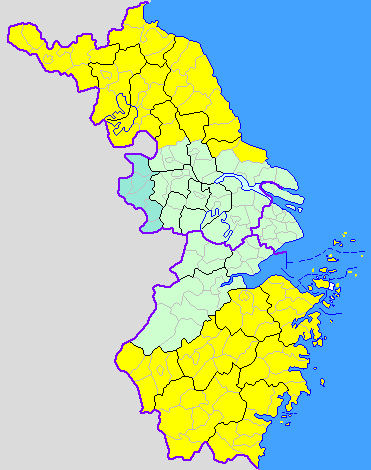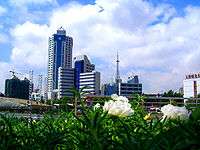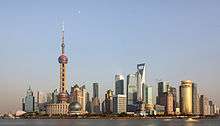Yangtze River Delta
| Yangtze River Delta 长江三角洲 | |
|---|---|
| Metropolitan region | |
 | |
 Map of Yangtze River Delta in Green | |
| Provincial | |
| Major Cities | Shanghai, Nanjing, Hangzhou, Suzhou, Ningbo, Wuxi, Nantong, Shaoxing, Changzhou, Jinhua, Jiaxing, Taizhou, Yangzhou, Yancheng, Taizhou, Zhenjiang, Huzhou, Huai'an, Zhoushan, Quzhou, Ma'anshan, Hefei |
| Government | |
| • Mayor of Shanghai | Yang Xiong |
| • Governor of Jiangsu | Li Xueyong |
| • Governor of Zhejiang | Li Qiang |
| • Governor of Anhui | Wang Xuejun |
| Population (2013) | |
| • Total | ~140,000,000 |
| Time zone | CST (UTC+8) |
| Yangtze River Delta | |
| Simplified Chinese | 长江三角洲 |
|---|---|
| Traditional Chinese | 長江三角洲 |
| Hanyu Pinyin |
|
| Romanization | Zankaon Saekohtseu |
The Yangtze River Delta, Yangtze Delta or YRD, also called Yangzi Jiang Delta, Changjiang Delta, River Chang Delta, Lake Tai Region or the Golden Triangle of the Yangtze, generally comprises the triangle-shaped territory of Wu-speaking Shanghai, southern Jiangsu province and northern Zhejiang province of China. The area lies at the heart of the region traditionally called Jiangnan (literally, "south of the Yangtze River"). The Yangtze River drains into the East China Sea. The urban build-up in the area has given rise to what may be the largest concentration of adjacent metropolitan areas in the world. It covers an area of 99,600 square kilometres (38,500 sq mi) and is home to over 115 million people as of 2013, of which an estimated 83 million is urban. If based on the greater Yangtze River Delta zone, it has over 140 million people in this region. Having a fertile soil, the Yangtze River Delta abundantly produces grain, cotton, hemp and tea.[1]
Early history
Since the fourth century, when the national capital was moved to Jiankang (present-day Nanjing) at the start of the Eastern Jin dynasty (AD 317–420), the Yangtze River Delta has been a major cultural, economic, and political centre of China. Hangzhou served as the Chinese capital during the Southern Song dynasty (1127–1279), and Nanjing was the early capital of the Ming dynasty (1368–1644) before the Yongle Emperor moved the capital to Beijing in 1421.
Other key cities of the region in pre-modern times include Suzhou and Shaoxing. The ancient Suzhou was the capital of the Wu state (12th century BC–473 BC), and the ancient Shaoxing was the capital of the Yue state (20th century BC?–222 BC). Nanjing first served as a capital in the Three Kingdoms period as the capital of Eastern Wu (AD 229–280). In these periods, there were several concomitant states or empires in China and each one had its own capital.
Population
The delta is one of the most densely populated regions on earth, and includes one of the world's largest cities on its banks — Shanghai, with a density of 2,700 inhabitants per square kilometre (7,000/sq mi). Because of the large population of the delta, and factories, farms, and other cities upriver, the World Wide Fund for Nature says the Yangtze Delta is the biggest cause of marine pollution in the Pacific Ocean.
Most of the people in this region speak Wu Chinese (sometimes called Shanghainese, although Shanghainese is actually one of the dialects within the Wu group of Chinese) as their mother tongue, in addition to Mandarin. Wu is mutually unintelligible with other varieties of Chinese, including Mandarin.
The area of the Yangtze River Delta incorporates more than twenty relatively developed cities in three provinces. The term can be generally used to refer to the entire region extending as far north as Lianyungang, Jiangsu and as far south as Wenzhou, Zhejiang. The region includes some of the fastest-growing economies in China in recent years, and as of 2004 has occupied over 21% of China's total gross GDP.[2]
The greater Yangtze River Delta metropolitan region
Since the ninth century, the Yangtze Delta has been the most populous area in China, East Asia, and one of the most densely populated areas of the world. During the mid to late period of the Tang dynasty (618-907), the region emerged as an economic centre, and the Yangtze River Delta became the most important agricultural, handicraft industrial and economic centre for the late Tang dynasty.
In the Song dynasty, especially during the Southern Song dynasty (1127–1279), with its capital situated in Lin'an (present-day Hangzhou), Lin'an became the biggest city in East Asia with a population more than 1.5 million, and the economic status of the Yangtze Delta became more enhanced. Ningbo became one of the two biggest seaports in East Asia along with Quanzhou (in Fujian province).
During the mid-late Ming dynasty (1368–1644), the first capitalism bud of the East Asia was born and developed in this area, although it was disrupted by the Manchu invasion and controlled strictly and carefully by the Confucian central government in Beijing, it continued its development slowly throughout the rest of the Qing dynasty (1644-1911). During the Ming and Qing dynasties, the delta became a large economic centre for the country, and also played the most important role in agriculture and handicraft industry.
During the Qianlong era (1735-1796) of the Qing dynasty, Shanghai began developing rapidly and became the largest port in the Far East. From late 19th century to early 20th century, Shanghai was the biggest commercial centre in the Far East. The Yangtze River Delta became the first industrialized area in China.
After the Chinese economic reform program, which began in 1978, Shanghai again became the most important economic centre in mainland China, and is emerging to become one of Asia's centres for commerce. In modern times, the Yangtze Delta metropolitan region is centred at Shanghai, and also flanked by the major metropolitan areas of Hangzhou, Suzhou, Ningbo, and Nanjing, home to nearly 105 million people (of which an estimated 80 million are urban residents). It is the centre of Chinese economic development, and surpasses other concentrations of metropolitan areas (including the Pearl River delta) in China in terms of economic growth, productivity and per capita income.
Cities

In 1982, the Chinese government set up the Shanghai Economic Area. Besides Shanghai, four cities in Jiangsu (Suzhou, Wuxi, Changzhou, Nantong) and five cities in Zhejiang (Hangzhou, Jiaxing, Shaoxing, Huzhou, Ningbo) were included. In 1992, a 14-city cooperative joint meeting was launched. Besides the previous 10 cities, the members included Nanjing, Zhenjiang and Yangzhou in Jiangsu, and Zhoushan in Zhejiang. In 1997, the regular joint meeting resulted in the establishment of the Yangtze River Delta Economic Coordination Association, which included a new member Taizhou in Jiangsu in that year. In 2003, Taizhou in Zhejiang also joined the association. In 2010, the association accepted six new members after a six-year observation and review, including Yancheng and Huai'an in Jiangsu, Jinhua and Quzhou in Zhejiang, and Ma'anshan and Hefei in Anhui. The total number of cities in the Yangtze River Delta Economic Coordination Association is now 22.[3] Some other cities that have been in consideration and in review include Wenzhou and Lishui in Zhejiang, Lianyungang and Xuzhou in Jiangsu, and Chuzhou, Wuhu, Tongling, Huainan and Xuancheng in Anhui.
- Urban cores: Shanghai (a municipality of China), Nanjing (the capital of Jiangsu Province), Hangzhou (the capital of Zhejiang Province), Suzhou, Ningbo, Wuxi.
- Jiangsu Province: Nanjing, Suzhou (including county-level urban centres of Changshu, Taicang, Kunshan, Wujiang and Zhangjiagang), Wuxi (including county-level urban centres of Jiangyin and Yixing), Nantong (including county-level urban centres of Rugao, Haimen, and Qidong), Changzhou (including county-level urban centres of Jintan and Liyang), Yangzhou (including urban centre of Yizheng), Yancheng (including county-level urban centres of Dafeng and Dongtai), Taizhou (including county-level urban centres of Jiangyan, Jingjiang, Taixing and Xinghua), Zhenjiang (including county-level urban centres of Danyang, Jurong and Yangzhong), Huai'an.
- Zhejiang Province: Hangzhou (including county-level urban centres of Lin'an, Fuyang, Tonglu, Jiande and Chun'an), Ningbo (including county-level urban centre of Cixi, Fenghua and Yuyao), Shaoxing (including county-level urban centres of Shangyu, Shengzhou and Zhuji), Jinhua (including urban centres of Dongyang, Lanxi, Yongkang and Yiwu), Jiaxing (including county-level urban centres of Haining, Pinghu and Tongxiang), Taizhou (including urban centre of Linhai), Huzhou, Zhoushan, Quzhou (including urban centre of Jiangshan).
- Anhui Province: Ma'anshan and Hefei have also been considered as among the cities in the greater Yangtze River Delta since 2010.[3]
- In addition, the Shanghai districts of Minhang, Jinshan, Jiading and Pudong, although nominally "districts", are all municipal-level in administration (Pudong is sub-provincial in administrative status), and all have de facto separate urban planning systems.
| City | Hanzi | Hanyu Pinyin | Wu | Regional Population(2010) | Non-agricultural Population of Urban Districts(2010)[4] | GDP(2011)(billion yuan) | Image |
|---|---|---|---|---|---|---|---|
| Shanghai | 上海 | Shànghǎi | Zaonhe | 23,019,148 | 12,286,274 | 1,919.57 |  |
| Nanjing (Jiangsu) |
南京 | Nánjīng | Noecin[note 1] | 8,004,680 | 6,852,984 | 614.55 |  |
| Hangzhou (Zhejiang) |
杭州 | Hángzhōu | Ghaontseu | 8,700,400 | 3,075,212 | 701.18 |  |
| Suzhou (Jiangsu) |
苏州/ 蘇州 |
Sūzhōu | Soutseu | 10,465,994 | 2,424,759 | 1,071.70 |  |
| Ningbo (Zhejiang) |
宁波/ 寧波 |
Níngbō | Nyinpou | 7,605,689 | 1,364,963 | 601.05 |  |
| Wuxi (Jiangsu) |
无锡/ 無錫 |
Wúxī | Vusih | 6,372,624 | 2,252,571 | 688.02 | |
| Changzhou (Jiangsu) |
常州 | Chángzhōu | Zantseu | 4,591,972 | 1,219,557 | 358.04 |  |
| Nantong (Jiangsu) |
南通 | Nántōng | Noethon | 7,282,835 | 1,361,003 | 408.02 |  |
| Shaoxing (Zhejiang) |
绍兴/ 紹興 |
Shàoxīng | Zaushin | 4,912,200 | 481,720 | 329.12 |  |
| Jinhua (Zhejiang) |
金华/ 金華 |
Jīnhuá | Cinho | 4,614,100 | 321,632 | 244.77 | |
| Jiaxing (Zhejiang) |
嘉兴/ 嘉興 |
Jiāxīng | Ciashin | 4,501,700 | 428,609 | 266.81 |  |
| Taizhou (Zhejiang) |
台州 | Tāizhōu | Thetseu | 5,968,800 | 310,464 | 279.49 | |
| Yangzhou (Jiangsu) |
扬州/ 揚州 |
Yángzhōu | Ghiantseu[note 1] | 4,459,760 | 1,705,209 | 263.03 | |
| Yancheng (Jiangsu) |
盐城 | Yánchéng | Ghiezen[note 1] | 7,260,240 | 892,874 | 277.13 | |
| Taizhou (Jiangsu) |
泰州 | Tàizhōu | Thatseu[note 1] | 4,618,558 | 551,730 | 242.26 |  |
| Zhenjiang (Jiangsu) |
镇江/ 鎮江 |
Zhènjiāng | Tsenkaon[note 1] | 3,113,384 | 671,808 | 231.04 |  |
| Huzhou (Zhejiang) |
湖州 | Húzhōu | Ghoutseu | 2,893,500 | 443,102 | 151.88 |  |
| Huai'an (Jiangsu) |
淮安 | Huái'ān | Ghuaoe[note 1] | 4,799,889 | 1,133,946 | 169.00 | |
| Zhoushan (Zhejiang) |
舟山 | Zhōushān | Tseuse | 1,121,300 | 281,423 | 76.53 |  |
| Quzhou (Zhejiang) |
衢州 | Qúzhōu | Jiutseu | 2,456,100 | 275,973 | 89.03 |  |
| Ma'anshan (Anhui) |
马鞍山/ 馬鞍山 |
Mǎ'ānshān | Mooese[note 1] | 1,366,302 | 532,410 | 114.42 |  |
| Hefei (Anhui) |
合肥 | Héféi | Ghehvi[note 1] | 7,457,466[note 2] | 1,783,612 | 363.66 |  |
Note:
- 1 2 3 4 5 6 7 8 The dialects in these areas are generally not Wu Chinese.
- ↑ including Chaohu City and Lujiang County
Transportation
The area is home to a very extensive transport network that include railways and expressways. The area has one of the highest private vehicle ownership rates in the country, and traffic rules governing Jiangsu, Shanghai, and Zhejiang are relatively strict compared to the rest of the country.
Main bridges
- Danyang–Kunshan Grand Bridge, longest bridge in the world (164.8 km or 102.4 mi),[5] carries the high-speed railway over the delta
- Donghai Bridge, Shanghai-Yangshan deep water port (Port of Shanghai), 32.5 km
- Hangzhou Bay Bridge, Ningbo-Shanghai, 36 km, the world's longest cross-sea bridge
- Runyang Bridge
- Jiangyin Suspension Bridge
- Nanjing Yangtze River Bridge
- Lupu Bridge, Puxi-Pudong
- Sutong Bridge
Sea
The region is served by some of the country's largest seaports:
- Port of Shanghai, sea & river, the world's largest container port and 2nd largest cargo port as of 2013
- Port of Ningbo-Zhoushan, sea & river, the world's largest cargo port as of 2013
- Port of Suzhou, river & lake, the world's sixth largest cargo port as of 2013
- Port of Lianyungang, sea port (not actually situated within the delta itself, but at the northern tip of the Jiangsu coastline)
- Port of Wenzhou, sea & river (not in the delta itself, but in southern Zhejiang province)
Air
The region has nine major airports, whose area of coverage is generally around an hour's drive from any point of the delta. They include:
- Shanghai Pudong International Airport, hub of China Eastern Airlines and Shanghai Airlines, situated in Pudong, Shanghai.
- Shanghai Hongqiao International Airport, closer to downtown Shanghai, serves domestic routes and limited international inter-city routes to other East Asian cities.
- Hangzhou Xiaoshan International Airport, situated in Hangzhou, Zhejiang.
- Nanjing Lukou International Airport, situated in Nanjing, Jiangsu.
- Ningbo Lishe International Airport, situated in Ningbo, Zhejiang.
- Wuxi Shuofang Airport, situated in Wuxi, Jiangsu.
- Changzhou Benniu Airport, situated in Changzhou, Jiangsu.
- Nantong Airport, situated in Nantong, Jiangsu.
- Yangzhou Taizhou Airport, situated in Yangzhou, Jiangsu.
Rail
- Jinghu railway (Beijing–Shanghai)
- Huning Railway (Shanghai-Nanjing)
High-speed Rail
- Beijing-Shanghai PDL
- Shanghai-Hangzhou PDL Part of the Hangzhou–Fuzhou–Shenzhen Passenger Dedicated Line and the Shanghai-Kunming PDL
- Shanghai–Nanjing Intercity High-Speed Railway
Bus Rapid Transit
- Changzhou BRT
- Hangzhou BRT
- Suzhou BRT
- Shanghai BRT (planning)
- Wuxi BRT (planning)
Light Rail
Metro
- Shanghai Metro
- Nanjing Metro
- Suzhou Rail Transit
- Hangzhou Metro
- Ningbo Rail Transit
- Wuxi Metro
- Changzhou Metro (under construction)
- Jiaxing Metro (under construction)
Climate
| Shanghai | ||||||||||||||||||||||||||||||||||||||||||||||||||||||||||||
|---|---|---|---|---|---|---|---|---|---|---|---|---|---|---|---|---|---|---|---|---|---|---|---|---|---|---|---|---|---|---|---|---|---|---|---|---|---|---|---|---|---|---|---|---|---|---|---|---|---|---|---|---|---|---|---|---|---|---|---|---|
| Climate chart (explanation) | ||||||||||||||||||||||||||||||||||||||||||||||||||||||||||||
| ||||||||||||||||||||||||||||||||||||||||||||||||||||||||||||
| ||||||||||||||||||||||||||||||||||||||||||||||||||||||||||||
The Yangtze Delta has a marine monsoon subtropical climate, with hot and humid summers, cool and dry winters, and warm spring and fall. Winter temperatures can drop as low as -10 °C (a record), however, and even in springtime, large temperature fluctuations can occur.
Fishing and agriculture
The Yangtze River Delta contains the most fertile soils in all of China. Rice is the dominant crop of the delta, but further inland fishing rivals it. In Qing Pu, 50 ponds, containing five different species of fish, produce 29,000 tons of fish each year. One of the biggest fears of fish farmers in this region is that toxic water will seep into their man-made lagoons and threaten their livelihood.
References
- ↑ "Yangtze (Yangzi, Changjiang) River Delta". China Today. Retrieved 27 March 2013.
- ↑ Shanghai Vice-Mayor Zhou Yupeng: 周禹鹏:加快推进长三角城市群的连带发展 People.cn retrieved 2010-01-09
- 1 2 合肥马鞍山挤上“长三角快车”
- ↑ source from 《中华人民共和国全国分县市人口统计资料2010》
- ↑ "Longest Bridge - Danyang-Kunshan Grand Bridge". Guinness World Records. Retrieved 11 December 2012.
External links
| Wikimedia Commons has media related to Chang Jiang—Yangtze River Delta. |
- PBS.org, Journey to Planet Earth, Yangtze River Delta, China
- United Nations Economic and Social Commission for Asia and the Pacific (UNESCAP): Yangtze River Delta
- Economic profile for the Yangtze River Delta — at HKTDC—Hong Kong Trade Development Council.
- Asian Times: "Growth cools in Yangtze River region"
- Golden Triangle extending to become a parallelogram? (Chinese) (Translate to English: Google, Bing)
- Constructing the next world megacity: The Yangtze Delta (Chinese) (Translate to English: Google, Bing)
